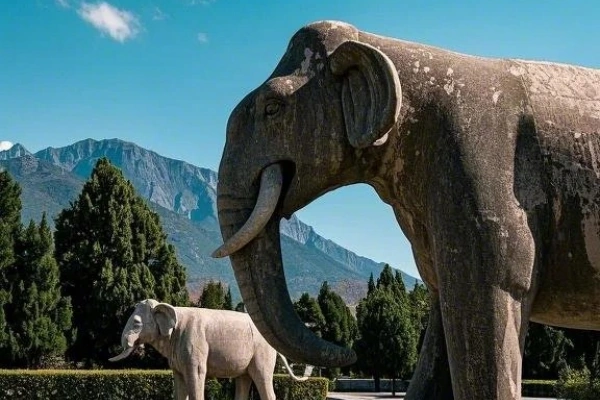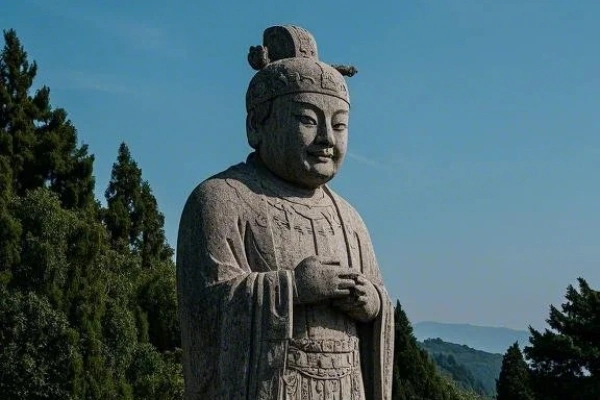Qianling Mausoleum
Historical Overview
Construction began in 684 CE, following Emperor Gaozong’s death, and concluded in 706 CE after Wu Zetian’s burial. The site was strategically chosen on Liangshan Hill, aligning with Tang geomancy principles to symbolize cosmic harmony. Over 100,000 laborers and artisans worked on the project, incorporating innovations like the "stone door" sealing system to deter tomb raiders. The mausoleum witnessed pivotal events, including Wu Zetian’s reign (690–705 CE), which blended Confucianism, Buddhism, and Daoism. In 1961, it became a national heritage site, and subsequent excavations revealed unparalleled Tang-era artistry, such as the Tomb of the Prince of Yi and its famed murals.
Structural Layout
The complex follows a hierarchical design centered on Liangshan Hill:
Central Tombs: The joint tomb of Emperor Gaozong and Wu Zetian, accessed via a 6.3-kilometer spirit path lined with 124 stone statues.
Subordinate Tombs: 17 smaller tombs for royalty and officials, including the Tomb of Prince Zhanghuai and Princess Yongtai, known for their exquisite murals.
Supporting Structures: The Sacred Way, stone bridges, and ceremonial pavilions, surrounded by inner and outer walls spanning 40 kilometers.
Major Attractions
Sacred Way Statues: A 1.2-kilometer avenue flanked by 61 stone figures, including winged horses, lions, and foreign dignitaries, symbolizing Tang’s multicultural empire.
Tomb of Prince Zhanghuai: Features 40 murals depicting court life, polo matches, and celestial beings, showcasing Tang realism.
Tomb of Princess Yongtai: Contains a jade coffin and murals of female attendants, reflecting aristocratic burial customs.
No-Door Tomb: Unrobbed and filled with gold, silver, and tri-color pottery, including a 1.2-meter-tall gold horse.
Qianling Museum: Displays over 1,000 relics, including the Golden Dragon Crown and Tang Dynasty Murals.
Liangshan Hill Summit: Offers panoramic views of the Wei River Valley and the mausoleum’s strategic layout.
Suggested Itineraries
Classic Route (3–4 hours):
Sacred Way → Tomb of Prince Zhanghuai → Tomb of Princess Yongtai → Qianling Museum → Liangshan Hill Summit
Highlights: Iconic statues, murals, and core tombs.
Extended Route (5–6 hours):
Sacred Way → No-Door Tomb → Tomb of Prince Yide → Xianqing Hall Ruins → Tang Murals Gallery → Liangshan Hill Summit
Highlights: Unrobbed tomb artifacts and lesser-visited sites.
Comprehensive Route (Full Day):
Sacred Way → All major tombs → Qianling Museum → Tang Murals Gallery → Hiking trails around Liangshan Hill
Ticket Purchase
Online: Book via the official Qianling Mausoleum website or WeChat mini-program (up to 3 days in advance).
On-Site: Tickets available at the entrance, but queues peak during holidays.
Prices:Peak Season (April–October): ¥122 (adults), ¥61 (students/seniors).
Off-Season (November–March): ¥82 (adults), ¥41 (students/seniors).
Free: Children under 1.2m, disabled visitors, and military personnel.
Transportation
By Bus: Take Bus 114 from Xi’an’s Xianyang Airport to Qian County, then a local taxi (¥15–20) to the site.
By Taxi: Direct ride from Xi’an (¥150–200 one-way, 1.5 hours).
By Tour Group: Day trips from Xi’an often include Qianling and the Famen Temple (¥300–500 per person).
Departure: Buses return to Xi’an until 5 PM; taxis are available at the exit.

Best Time & Tips
Peak Hours: Avoid 11 AM–2 PM; visit early (8:30 AM opening) or late (after 3 PM).
Crowds: Weekends and national holidays are busiest; weekdays are quieter.
Weather: spring (April–May) and autumn (September–October) offer mild temperatures.
Essentials:Wear sturdy shoes (uneven terrain and hiking trails).
Bring sunscreen, a hat, and water (limited shade on-site).
Photography allowed (no flash in tombs).
Prohibited items: Drones, large bags, and climbing on statues.
This guide ensures a respectful and enriching visit to one of China’s most significant archaeological sites, blending history, art, and natural beauty.
Contact Us
What Our Clients Say?
Based on 10,000+ traveler reviews















